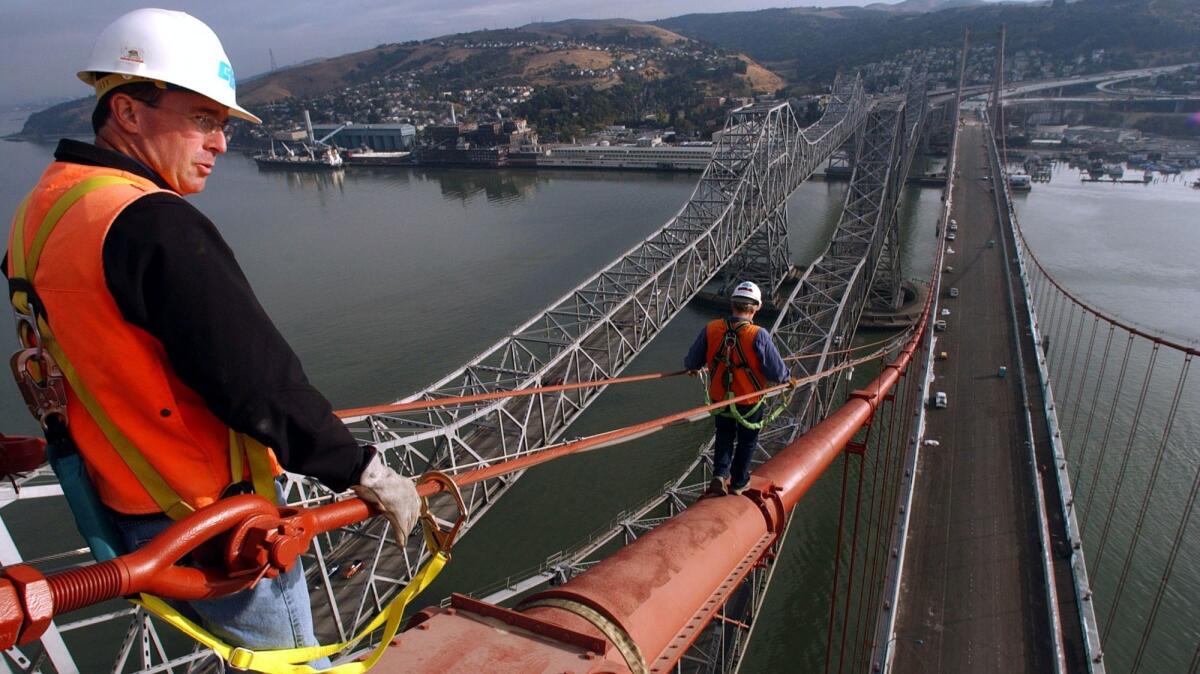Op-Ed: Fixing America’s infrastructure is a once-in-a-lifetime opportunity to build a better workforce

- Share via
Everyone knows America’s infrastructure is crumbling and in desperate need of attention. But that’s far from the only looming national deficit. Our human capital is just as depleted. There’s a growing mismatch between workers and jobs that’s threatening the American Dream for millions of families.
Hoping to distract from the chaos in Washington, the Trump administration has been trying to start conversations about both problems. What the president doesn’t seem to grasp is that the two challenges are best addressed together. There’s no way we can rebuild our roads and bridges without qualified workers — engineers, estimators, skilled tradesmen and others. And a moonshot infrastructure initiative of the kind being talking about in Washington is a once-in-a-lifetime opportunity to advance a skills agenda on the scale needed today.
The skills gap, growing quietly for decades, is now reaching crisis proportions. Survey after survey finds employers complaining about employees’ skills. Even with unemployment at the lowest point in a decade, 6 million jobs stand empty — generally because companies can’t find workers equipped to fill them. Educated workers’ wages are rising; those without skills are falling further and further behind. Worse, many workers who lack needed skills are dropping out of the labor force.
A national infrastructure initiative can jump-start new training nationwide by creating incentives for employers who get infrastructure contracts to launch workforce programs. One of the simplest ways to do this: allow trainees to use federal financial aid — Pell Grants — to cover part of the cost.
A combined infrastructure-training initiative offers the president an opportunity for a badly needed reset: a chance to reach across the aisle.
Educators, employers and policymakers agree that job training works best when there’s an employer involved — to make sure trainees are learning the skills in demand in today’s job market. But employers busy running businesses on tight profit margins are often slow to get involved, whether offering training themselves or partnering with educators.
The Obama administration experimented with using federal financial aid to encourage more job training. The Educational Quality through Innovative Partnerships initiative, or EQUIP, allows colleges to partner with nontraditional, unaccredited training providers to offer programs that prepare students for jobs — and allows students to use federal financial aid, loans as well as Pell Grants usually reserved for credit-bearing courses at degree-granting institutions, to pay for the instruction.
Tinkering with federal financial aid for education is sure to be controversial, and EQUIP is tiny: just eight sites nationwide, almost all of them computer-coding boot camps or online-education providers. An infrastructure initiative would have to be bigger and bolder. After all, rebuilding America’s infrastructure is going to involve hundreds of thousands of workers doing many different kinds of jobs.
Here’s how it could work in practice: A construction contractor specializing in bridge repair might need to ramp up fast to bid on a contract — and need to hire dozens of welders to get the job done. The company could create an in-house training program, or it could contract out to a union or to a training center affiliated with a contractors association. Programs would combine in-class hours with on-the-job training — like an apprenticeship, only shorter and more focused. Company, union or employer association would offer most or all the instruction but partner with an educational institution — most likely a community college — that would monitor quality and handle the government paperwork.
Trainees would learn new skills and earn college credit, along with industry credentials certifying their new skills. The contractor would be responsible for covering part of the cost, including wages for trainees. But the taxpayer would help, just as we help cover the cost of college for many young people — with federal financial aid.
The toughest challenge will be quality control. We’ve learned the hard way in recent years what can happen when Washington allows students to use federal financial aid at educational institutions that make extravagant promises and don’t deliver for indebted students. But past mistakes have bred new thinking, and there are many options for quality control — including pay-for-performance contracts and making sure both companies and colleges have enough skin in the game that they insist on effective training.
There are reports that the Trump administration will announce a new job training plan on Wednesday. Rumors suggest the president is thinking about expanding the EQUIP experiment, but not linked to infrastructure. And the White House may be tempted to go it alone, making new money available for training without consulting Congress.
That’s not the way to handle what could be a decade-defining infrastructure project. A combined infrastructure-training initiative offers the president an opportunity for a badly needed reset: a chance to reach across the aisle, building on an Obama-era program with a bipartisan solution for two of the nation’s most pressing problems.
Combining infrastructure and job training would pay off in the short run, providing the workers we need to rebuild roads and bridges. But the real dividend would be long-term: new habits and new partnerships between companies and colleges and a new public-private approach to training that could apply to all kinds of jobs, beyond construction. Everyone would win — Democrats, Republicans, employers and employees, rebuilding our physical underpinnings and rekindling the American Dream.
Tamar Jacoby is president of Opportunity America, a Washington nonprofit that promotes economic mobility.
Follow the Opinion section on Twitter @latimesopinion and Facebook
More to Read
A cure for the common opinion
Get thought-provoking perspectives with our weekly newsletter.
You may occasionally receive promotional content from the Los Angeles Times.









